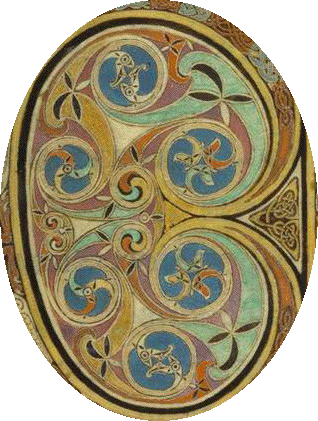|
 |
|
One reason to study organic chemistry is that it involves concepts that enrich your life in unexpected ways.
The concept of chirality, which is so central in the structural theory of organic chemistry, is important in many other areas - such as design, and perhaps even theology. These problems should help you appreciate the generality, and arbitrariness, of the classification that is involved in the CIP nomenclature for describing the absolute configuration of molecules.
Around the year 710 Eadfrith, Bishop of Lindisfarne, an island monastery in the North Sea off the coast of Northumbria, prepared an illuminated copy of the gospels. It survived Viking raids, depradations of the Reformation, and, according to legend, being washed overboard on an abortive trip to Ireland, to become one of the oldest and most important treasures of the British Library.
Eadfrith filled 15 of the 259 pages of his "Lindisfarne Gospels" with drawings or elaborate designs. (Click here if you'd like to enjoy the British Library site which displays these pages.)
In illuminating "quoniam", the first word in the Gospel of Mark, Eadfrith filled the opening of the letter q with a set of six roundels each containing a geometric pattern on a blue field. Each of these patterns has two-dimensional chirality in shape and four of them (as well as two smaller "pinwheels") also show two-dimensional chirality in their use of the colors yellow, red, and green.
It appears that Eadfrith was aiming for approximate symmetry but made a mistake with his roundels (perhaps intentionally so as not to seem to be claiming divine perfection for his masterpiece - this is where theology comes in).
|
 |
|
1)
Devise a system to give an absolute designation of the chirality of
the geometric patterns in the roundels and another system to
designate their color-based chirality.
[It is important to note that in devising your systems you
must assume that the person with whom you are communicating shares
your understanding of "clockwise" or a related concept.]
2) Use your two systems to assign chirality to each of the elements in Eadfrith's design and suggest where he made his "mistake".
3) Ignoring modest distortions (and his "mistake), is Eadfrith's overall design chiral or "meso"?
4) Consider the knot in the triangular opening at the right of the q (enlarged right). How does Eadfrith show its three-dimensionality? Is the knot symmetrical? Is it chiral?
|
|
|
|